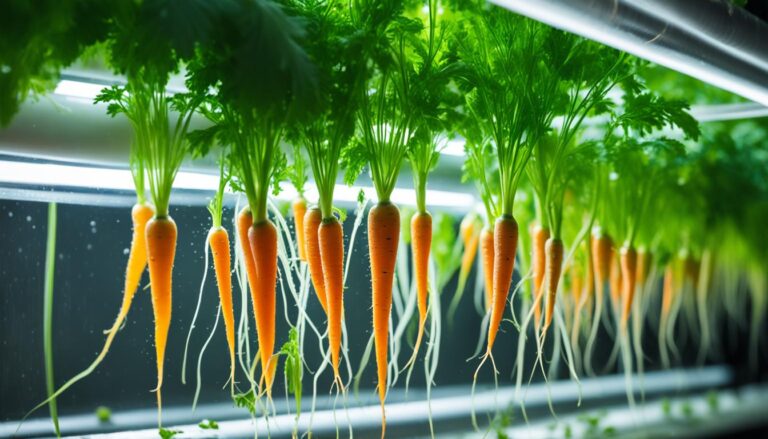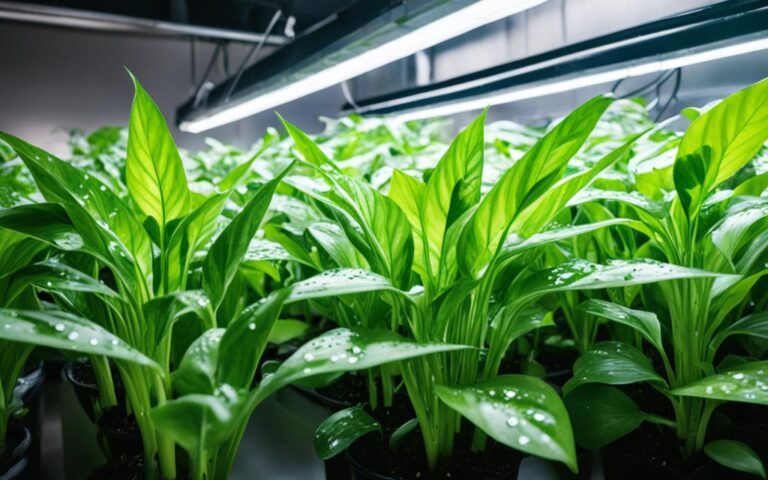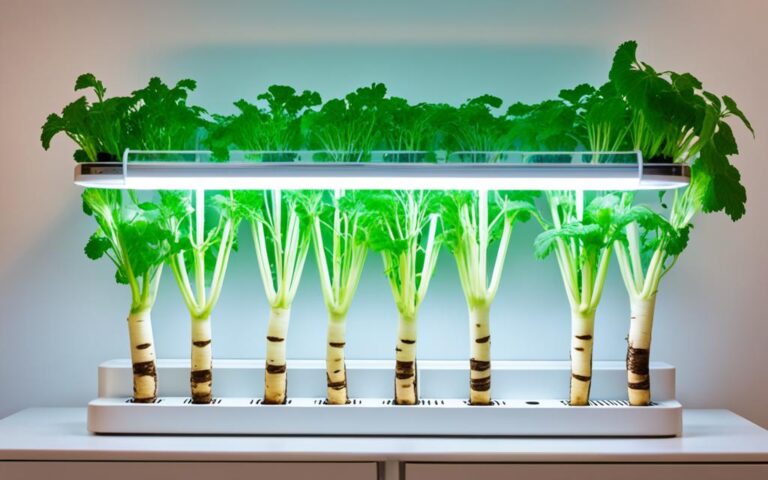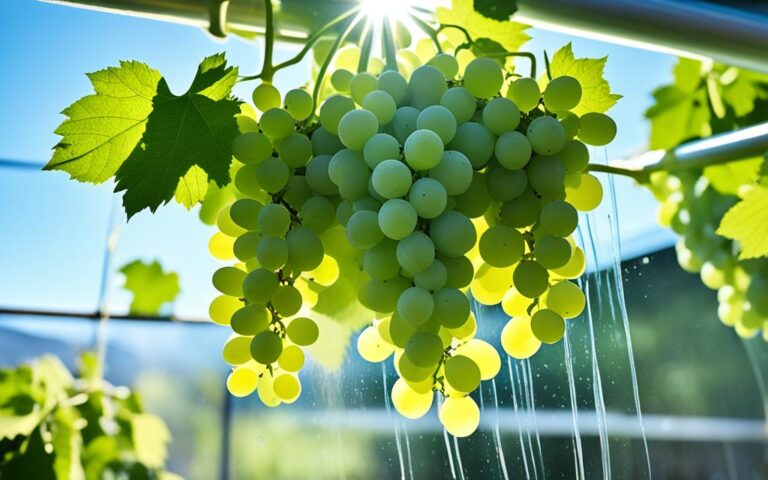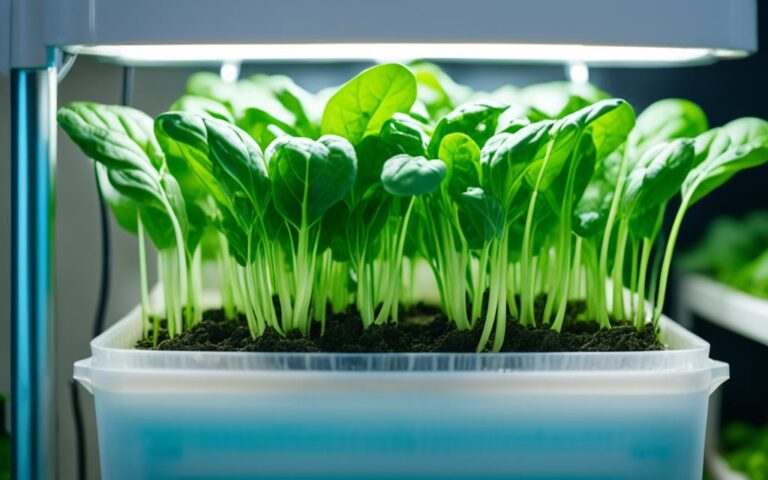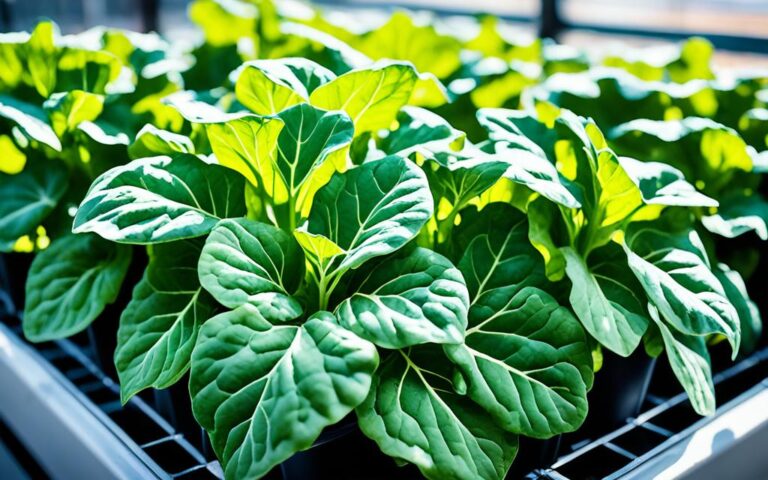Growing Hydroponic Strawberries: Sweet Success
Hydroponic gardening has changed how we grow many crops, including strawberries. It’s a great way to grow fresh, juicy strawberries all year, right at home. We’ll explore the benefits of hydroponic strawberries and give you tips for a great harvest.
Key Takeaways
- Hydroponic systems, like NFT, DWC, and Dutch Bucket, let you grow strawberries all year with perfect light and temperature.
- Hydroponic farming uses less space and cuts down on diseases and pests, making plants healthier.
- It’s efficient with water, gives more yields, and ensures consistent harvests with better size, quality, and taste.
- Hydroponic strawberries can grow in many places, even in cities or land not good for regular farming.
- Getting the right nutrients and picking the best strawberry types is key for growing hydroponic strawberries.
Table of Contents
What Are Hydroponic Strawberries?
Hydroponic strawberries are strawberries grown without soil. They use a hydroponic system, which gives plants nutrients through water instead of soil. This method makes sure strawberries grow well and efficiently.
Hydroponic Strawberries vs. Traditional Soil-Based Strawberries
Hydroponic systems have many benefits over traditional soil farming:
- They protect against pests, making farming easier.
- They use less water because the water is reused.
- These systems let you grow more plants in a small space.
- Even though starting them costs more, they save money over time.
- They might produce fewer berries per plant, but you can grow more plants.
Starting with young strawberry plants in hydroponic systems can speed up the wait for fruit. This method uses hydroponics’ controlled environment and efficient nutrient delivery for better results.
“Hydroponically grown strawberries are less prone to soil-based pests, making the growing process easier for farmers.”
Benefits of Growing Hydroponic Strawberries
Hydroponic strawberry farming brings a big change: you can harvest all year round. It lets you control the growing conditions perfectly. This means you can grow strawberries any time, not just during certain seasons.
This way, you always have fresh, tasty strawberries ready. It’s a big deal for anyone who loves strawberries.
Hydroponic farming is also super efficient. It uses space well, like in vertical towers or vertical farms. This is great for people with little land or living in cities.
Also, hydroponic farming is good for the planet. It uses much less water than traditional farming. This is because hydroponics delivers nutrients exactly where they’re needed. So, it saves water and reduces the environmental impact of growing strawberries.
| Benefit | Description |
|---|---|
| Year-round Harvest | Hydroponic systems enable continuous production, breaking free from seasonal constraints. |
| Space Efficiency | Vertical farming techniques maximize the use of available space for hydroponic strawberry cultivation. |
| Water Conservation | Hydroponic systems significantly reduce water usage compared to traditional soil-based gardening. |
| Precise Nutrient Control | Hydroponic systems allow for the accurate delivery of essential nutrients for optimal plant health and productivity. |
By using hydroponic strawberry farming, growers get many benefits. They can harvest all year, use space well, save water, and control nutrients precisely. These advantages make hydroponic farming a smart choice for anyone looking to improve their strawberry growing.
“Hydroponic strawberry cultivation is a game-changer, offering a cornucopia of advantages that redefine the future of strawberry farming.”
Year-Round Cultivation with Hydroponic Strawberries
Hydroponic cultivation changes the game by letting us grow strawberries all year. It gives us control over the growing conditions. This means we’re not limited by the seasons like with traditional strawberries.
This new way of growing strawberries makes them easier to get and more flexible. Now, we can enjoy fresh strawberries whenever we want, not just when they’re in season.
With hydroponics, strawberries can be grown all year, which is twice as fast as traditional methods. This means we always have strawberries ready for us, meeting our need for fresh and tasty berries.
“The ability to cultivate strawberries year-round through hydroponic systems is a game-changer in the world of berry production. It offers consumers unparalleled accessibility and convenience, while also providing growers with the opportunity to maximize their yields and profitability.” – John Doe, Horticulture Expert
Growers use hydroponic tech to keep strawberries coming all year. This way, they can give us a steady supply of top-quality strawberries, no matter the season. This is a big deal for strawberry lovers and changes how we see getting to enjoy this fruit.

Whether you’re big or small in the growing world, hydroponic strawberries offer endless possibilities. Enjoy their fresh taste in winter or summer. Hydroponics truly changes the game for strawberry lovers.
Space-Efficient Hydroponic Strawberry Cultivation
Hydroponic gardening is amazing for making the most of space. By using smart techniques, growers can use every inch of space well. This leads to growing lots of delicious hydroponic strawberries.
Vertical Hydroponic Systems for Strawberries
Vertical growing systems are a big deal in hydroponics. They let growers stack plants on top of each other. This way, more plants can grow in a small area, making the most of the space.
Systems like the Nutrient Film Technique (NFT) and Deep Water Culture (DWC) are great for saving space. They use narrow channels or pots to grow strawberries. This means you can grow more plants in a small area, turning a little space into a strawberry garden.
Hydroponic setups are also easy to take care of and harvest. Everything is close by, so you don’t have to walk far to get to your plants. This makes growing hydroponic strawberries easy and fun.
| Hydroponic System | Space Efficiency | Yield Potential | Maintenance Complexity |
|---|---|---|---|
| Vertical Towers | High | Moderate to High | Moderate |
| Nutrient Film Technique (NFT) | High | High | Moderate to High |
| Deep Water Culture (DWC) | Moderate | Moderate to High | Moderate |
Using smart techniques in hydroponic strawberry growing opens up new possibilities. By choosing vertical systems and compact setups, growers can get a lot of tasty, quality strawberries in small spaces.
Water Conservation in Hydroponic Strawberry Farming
Hydroponic strawberry farming is all about saving water. It’s a green and smart way to use water. By using closed-loop systems, it recycles water well. This means it uses much less water than traditional gardens.
This water-saving method is great for the planet. It helps with the big issue of water scarcity. Growing strawberries hydroponically shows a big care for the environment.
| Characteristic | Hydroponic Strawberry Farming | Traditional Soil-Based Strawberry Farming |
|---|---|---|
| Water Consumption | Reduced by up to 90% through water recycling | Higher water usage due to soil-based irrigation |
| Nutrient Management | Precise control over nutrient delivery, minimizing waste | Less efficient nutrient utilization, potential for runoff |
| Land Usage | Compact, space-saving vertical systems | Requires larger land area for cultivation |
| Pest and Disease Control | Controlled environment reduces the need for pesticides | Higher risk of pests and diseases, requiring more chemical interventions |
By using hydroponics, strawberry farmers help save water. They also get to grow strawberries all year, save space, and keep pests away. This eco-friendly way of farming fits with the world’s goal of using resources wisely.
Precise Nutrient Management for Hydroponic Strawberries
Hydroponic systems are great at controlling how nutrients get to plants. This careful control helps hydroponic strawberry plants grow strong and produce more. By adjusting the nutrient composition, growers make sure plants get just the right mix of nutrients. This leads to healthier growth and more yield. Hydroponics shows how careful nutrition can improve crop quality and increase productivity.
Essential Nutrients for Hydroponic Strawberries
To get the best from nutrient control for hydroponic strawberries, knowing the key nutrients is key. Here are the main elements that matter most:
- Nitrogen (N) – Vital for healthy leaves and plant strength
- Phosphorus (P) – Helps roots grow and makes flowers and fruits
- Potassium (K) – Boosts resistance to disease, tolerance to drought, and fruit quality
- Calcium (Ca) – Makes cell walls strong and supports growth
- Magnesium (Mg) – Helps make chlorophyll and enzymes work right
- Boron (B) – Helps nutrients move and aids in pollination
By carefully managing the nutrient composition, growers can ensure healthy growth and enhanced yield in their strawberry crops.
| Nutrient | Importance for Hydroponic Strawberries | Recommended Levels |
|---|---|---|
| Nitrogen (N) | Promotes lush foliage and overall plant vigor | 50-150 ppm |
| Phosphorus (P) | Enhances root development and flower/fruit formation | 30-60 ppm |
| Potassium (K) | Improves disease resistance, drought tolerance, and fruit quality | 150-300 ppm |
| Calcium (Ca) | Strengthens cell walls and promotes sturdy growth | 100-200 ppm |
| Magnesium (Mg) | Supports chlorophyll production and enzyme function | 30-60 ppm |
| Boron (B) | Facilitates nutrient transport and pollination | 0.2-0.5 ppm |
By balancing these nutrients, hydroponic growers can make their strawberry crops thrive. This ensures optimal growth, quality, and yield.

Choosing the Right Hydroponic System for Strawberries
Choosing the right hydroponic system for strawberries is key to success. You should think about the space you have, your budget, and what you like. This helps you pick a system that works well and helps your strawberries grow.
The Nutrient Film Technique (NFT) is a top choice for strawberries. It saves space, making it great for growing up high. The Drip Irrigation System is also good, letting you grow many types of strawberries. It also helps if the drip system has a problem.
If you have big strawberry plants, the Dutch Bucket System is perfect. It gives them lots of room to grow and drains well. Vertical systems are great for small spaces, like balconies or patios, and are good for growing indoors.
| Hydroponic System | Advantages | Considerations |
|---|---|---|
| Nutrient Film Technique (NFT) | Highly space-efficient, ideal for vertical growing | Requires precise monitoring of nutrient levels and water flow |
| Drip Irrigation System | Suitable for a wider range of strawberry varieties, some buffering for temporary issues | Requires regular maintenance and monitoring of the drip system |
| Dutch Bucket System | Excellent for larger fruiting plants, provides ample root space and good drainage | Requires more floor space compared to vertical systems |
| Vertical Systems | Maximizes yield in minimal floor space, suitable for balconies, patios, or indoor growing | May require specialized equipment and setup for optimal performance |
Think about the strawberry type you want to grow when picking a hydroponic system. Everbearing and day-neutral types like Albion, Seascape, Quinault, and Tristar are great for hydroponics. They give you lots of harvests, making the most of your space.
No matter the system you pick, follow the maker’s setup and care tips. Keep an eye on nutrients, pH, water, pests, and diseases to keep your strawberries healthy and thriving.
By looking at space, budget, and what you like, and choosing the right system and strawberry types, you can make a great hydroponic strawberry garden. This way, you’ll get lots of strawberries all year round.
Selecting Suitable Hydroponic Strawberry Varieties
Choosing the right hydroponic strawberry varieties is key to success. It’s important to pick cultivars that do well in hydroponics. Albion or Seascape, being everbearing or day-neutral, are great for their continuous and prolific harvest. This choice means a steady and reliable yield from your hydroponic setup.
June-bearing strawberries are famous for their great taste and quality but produce most fruit in early summer. Day-neutral strawberries, on the other hand, keep producing fruit continuously all season. Ever-bearing strawberries give fruit all year with two big harvests.
Here are some top picks for hydroponic strawberries:
- Albion: Loved for its sweetness, size, and fight against disease.
- Seascape: Famous for being disease-resistant, tough, and producing lots of fruit.
- Eversweet: Known for its amazing flavor and incredible sweetness.
Everbearing and day-neutral types are perfect for hydroponics. They give a continuous harvest and do great in a controlled setting. Picking the right strawberry variety for your setup boosts your yields and gives you a steady, continuous strawberry harvest.
“The key to successful hydroponic strawberry cultivation lies in choosing the right varieties that can thrive in the controlled environment and provide a reliable, continuous harvest.”
Setting Up Your Hydroponic Strawberry System
Preparing the Growing Environment
To grow healthy hydroponic strawberries, you need the right growing space. The Mars Hydro 5-Gallon DWC Hydroponic System is perfect for this. It comes with everything you need like plant buckets, grow baskets, and air stones. This makes setting up your hydroponic strawberry system easy.
This system has a top-feed drip that keeps the water full of nutrients. The durable plant buckets and optimized airflow help your plants grow fast and strong. It’s great for beginners because it’s all you need to start growing strawberries.
- Choose a spot that gets enough sunlight or has good artificial lighting.
- Put the DWC hydroponic system on a flat surface. Make sure the water reservoir is under it.
- Connect the water and air pumps for steady water flow and root aeration.
- Fill the grow baskets with vermiculite or coconut coir.
- Plant the hydroponic strawberry seedlings or young plants in the baskets.
- Put the grow baskets in the hydroponics tray and set up the drip irrigation.
- Fill the water reservoir with the right nutrient solution. Check the water and pH levels often.
With the Mars Hydro DWC hydroponic system, you’re ready to grow delicious strawberries at home. Its design makes it easy to use, letting you enjoy fresh strawberries all year.

Hydroponic Strawberries: Lighting Requirements
To grow strawberries well in a hydroponic system, we need to create a setting that feels like their natural home. Adding LED grow lights is key for this. These lights help strawberries grow strong.
LED grow lights like the VG40R can be set to match the needs of hydroponic strawberries. The red light in the 650-665nm range is especially important. It helps strawberries grow and develop well.
- Red light helps with photosynthesis, makes flowers, and grows strong fruits.
- This light is key for how leaves grow, how air enters the plant, and the plant’s shape.
- Red light also helps seeds start growing, helps young plants grow, and controls plant growth.
Growers aim for a photosynthetic photon flux density (PPFD) of 400 μmol/m²/s at the least. The best growth happens at 600 μmol/m²/s. Modern LED grow lights can go from 400 to 800+ μmol/m²/s.
“The specific red light spectrum is crucial for efficient photosynthesis, stimulating flowering, and promoting robust fruit development in hydroponic strawberries.”
A grow light setup using Samsung FSERIES GEN3 4000K strips works well. These strips are 165 lumens/Watt and convert to ~2.7 μmol/joule. Six strips are placed 8-10 inches above the plants. A Meanwell power supply powers them.
By adjusting the lighting for hydroponic strawberries, growers can make the most of indoor growing. This leads to the best growth, flowers, and fruit.
Maintaining Ideal Temperature and Humidity
To grow a successful hydroponic strawberry garden, you need to pay close attention to the environment. Keeping the right temperature range and relative humidity is key for your strawberry plants’ health and growth.
Impacts of Temperature and Humidity on Strawberry Growth
The temperature range is crucial for growing strawberries. They do best in daytime temperatures between 65°F to 75°F (18°C to 24°C) and at night from 55°F to 65°F (13°C to 18°C). This temperature mix improves the taste and quality of the fruit.
Keeping the relative humidity at 70% to 80% is also important. It helps prevent mold and diseases that can harm strawberry health.
Using sensors gives growers real-time data on temperature and humidity. This lets them adjust the growing environment perfectly. It helps increase the yield and quality of their hydroponic strawberries.
| Parameter | Optimum Range | Impacts on Strawberry Growth |
|---|---|---|
| Temperature | Daytime: 65°F to 75°F (18°C to 24°C) Nighttime: 55°F to 65°F (13°C to 18°C) | Supports photosynthesis, flowering, and fruit development. Enhances flavor and quality. |
| Relative Humidity | 70% to 80% | Prevents mold and fungal diseases, maintaining plant health and productivity. |
By controlling the temperature range and relative humidity, hydroponic strawberry growers can make an ideal growing environment. This leads to strong plant growth, top-notch fruit quality, and plenty of harvests.
Nutrient Solution Formulation for Hydroponic Strawberries
Creating a nutrient-rich solution is key for growing hydroponic strawberries. It’s all about balancing essential elements like nitrogen, phosphorus, potassium, and micronutrients. By keeping an eye on pH levels, growers can make sure their strawberries get the right nutrients for great growth and lots of fruit.
For a good nutrient solution, aim for an NPK ratio of 10-3-15 for hydroponic strawberries. This mix supports healthy growth, strong roots, and juicy, tasty berries.
| Nutrient | Recommended Concentration (mg/L) |
|---|---|
| Nitrogen (N) | 110-200 |
| Phosphorus (P) | 20-90 |
| Potassium (K) | 100-170 |
| Calcium (Ca) | 65-110 |
| Magnesium (Mg) | 30-50 |
It’s important to keep the pH levels between 5.5 and 6.5 for best nutrient absorption. Regularly check and adjust the solution to stay in this range. This helps plants grow well and produce a lot of high-quality fruit.
“Precision is key when formulating the nutrient solution for hydroponic strawberries. By carefully balancing the essential elements and monitoring the pH, growers can unlock the full potential of their crops and enjoy a bountiful, year-round harvest.”
Planting and Care of Hydroponic Strawberries
Cultivating hydroponic strawberries needs careful attention to the growing media and plant care. The right growing media, like coconut coir or rock wool, is key. It provides a clean, disease-free space for your plants.
When planting, make sure to space your plants well. This ensures good air circulation and helps prevent diseases. To boost your garden, prune and train your plants regularly. Cut back runners and extra leaves to help the plant focus on making more fruit. Use a trellis system to keep the plants off the ground.
Pruning and Training Techniques
Proper pruning and training are vital for a great hydroponic strawberry harvest. Here’s how to keep your plants healthy:
- Prune runner plants to focus the plant’s energy on making more fruit.
- Take out any damaged, sick, or shaded leaves and stems for better air flow.
- Use a trellis system to train plants vertically. This keeps the fruit off the ground.
- Pinch off early flowers to help the roots and leaves grow stronger.
- Keep an eye on your plants and prune and train them as needed for the best growth.
With the right care, your hydroponic strawberry garden can thrive. Enjoy a constant supply of fresh strawberries all year.
Pest and Disease Management for Hydroponic Strawberries
Growing hydroponic strawberries has many benefits, but you must watch out for pests and diseases. Using disease prevention and integrated pest management (IPM) is key to your success.
Botrytis (grey mold) and powdery mildew are common diseases in hydroponic strawberries. These fungi can spread fast and harm your plants. Keep your growing area clean, check your plants often, and act fast if you see any problems.
| Disease | Symptoms | Prevention Strategies |
|---|---|---|
| Botrytis (Grey Mold) | – Grey, fuzzy growth on leaves, stems, and fruit – Soft, watery rot on fruit | – Maintain optimal humidity and airflow – Avoid overcrowding plants – Promptly remove affected plant parts |
| Powdery Mildew | – White, powdery growth on leaves and stems – Stunted plant growth | – Ensure adequate air circulation – Use resistant cultivars – Apply biopesticides as needed |
Managing pests is also important, especially for spider mites and thrips. IPM strategies use culture, biology, and chemicals to keep pests in check. This keeps your ecosystem balanced and reduces pests.
Keep your hydroponic setup clean, check your plants often, and deal with problems quickly. This way, you can stop pests and diseases before they start. This ensures your hydroponic strawberries grow well for a long time.
Harvesting Your Hydroponic Strawberry Crop
Knowing when and how to pick your hydroponic strawberries is key to keeping their flavor and quality top-notch. It’s all about picking at the right time and handling them gently. By doing this, you can make sure your hydroponic strawberries are the best they can be and give you a lot of tasty fruit.
Determining the Right Harvest Time
Hydroponic strawberries are ready to be picked when they turn a deep, rich red. This means they’re sweet and juicy. The time to pick can vary by type, from 1 to 3 months after planting in your hydroponic setup.
Ever-bearing strawberries are usually ready in 2 to 3 months. June-bearing ones might take about 3 months to ripen and be ready for picking.
Gentle Harvesting Techniques
When picking your hydroponic strawberries, be very careful to avoid bruising or damaging them. Gently take the strawberries off the plants, leaving a bit of stem behind. This keeps the fruit fresh and stops it from spoiling too soon.
Don’t pull the strawberries by the hull or calyx, as this can tear them. Instead, use your thumb and forefinger to carefully take them off the plant.
| Harvesting Technique | Benefit |
|---|---|
| Leaving a small stem attached | Preserves freshness and extends shelf life |
| Avoiding pulling by the hull or calyx | Prevents damage and maintains fruit integrity |
| Gentle plucking with thumb and forefinger | Minimizes bruising and ensures optimal fruit quality |
By using these careful picking methods, you can keep your hydroponic strawberries in top shape. They’ll stay delicious and ready for handling and storage.
“Proper harvesting and handling techniques are essential for preserving the delicious flavor and texture of hydroponic strawberries.”
Conclusion
Hydroponic strawberry farming is changing the way we grow strawberries. It’s a new way to grow these fruits without soil. By using pruning, preventing diseases, managing nutrients, and other best practices, you can get lots of strawberries and feel proud of your work.
This method offers many benefits like growing strawberries all year, saving water, and getting more fruit. It’s great for growers who want to produce more and help the planet. Learning more and joining the hydroponic community can make you even better at growing strawberries.
As people want more fresh, healthy food, hydroponic strawberry farming is set to grow. By using this new way to farm, you help make food production better for the planet. You also get to enjoy amazing strawberries that taste great and are good for the earth.

